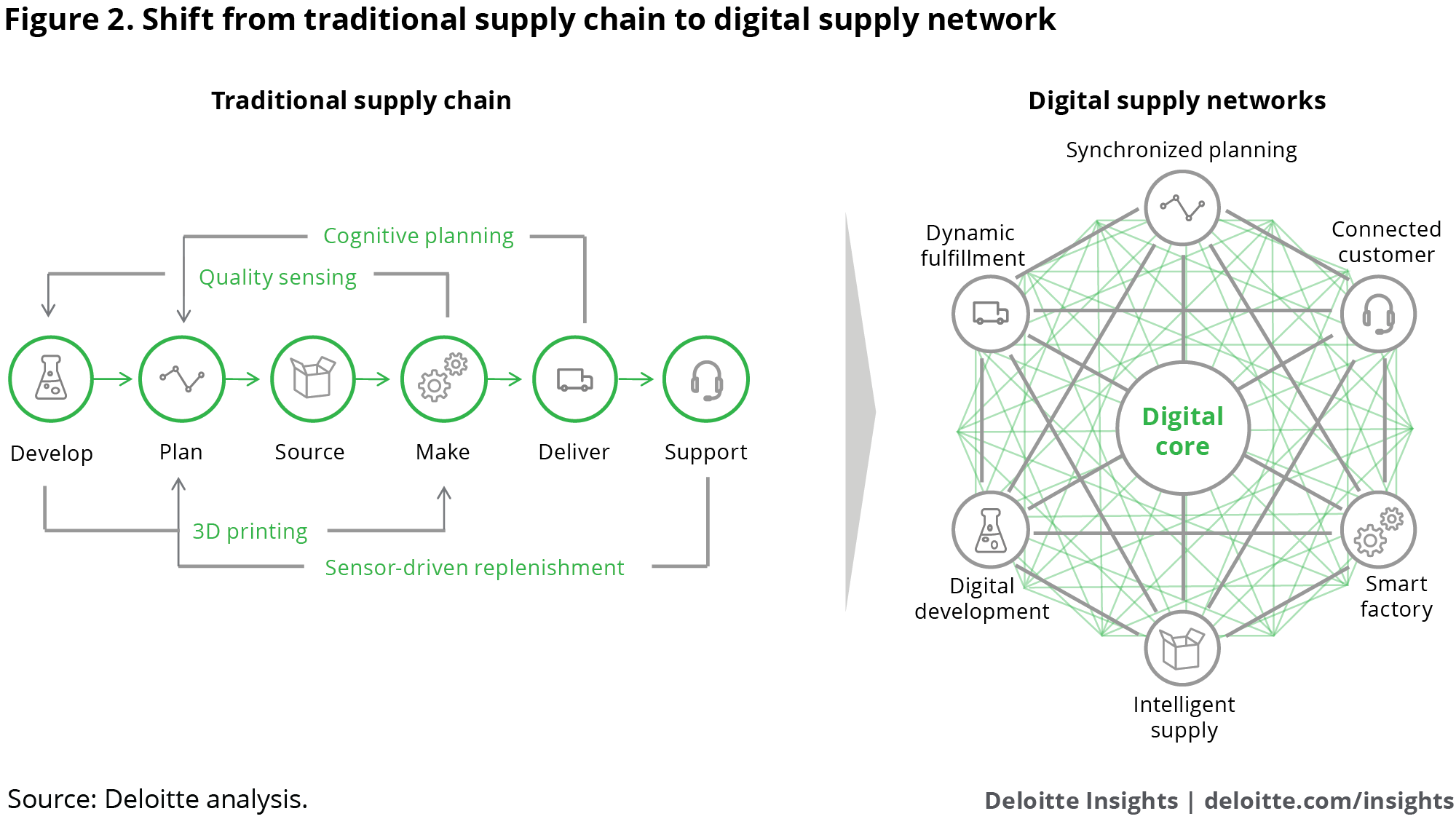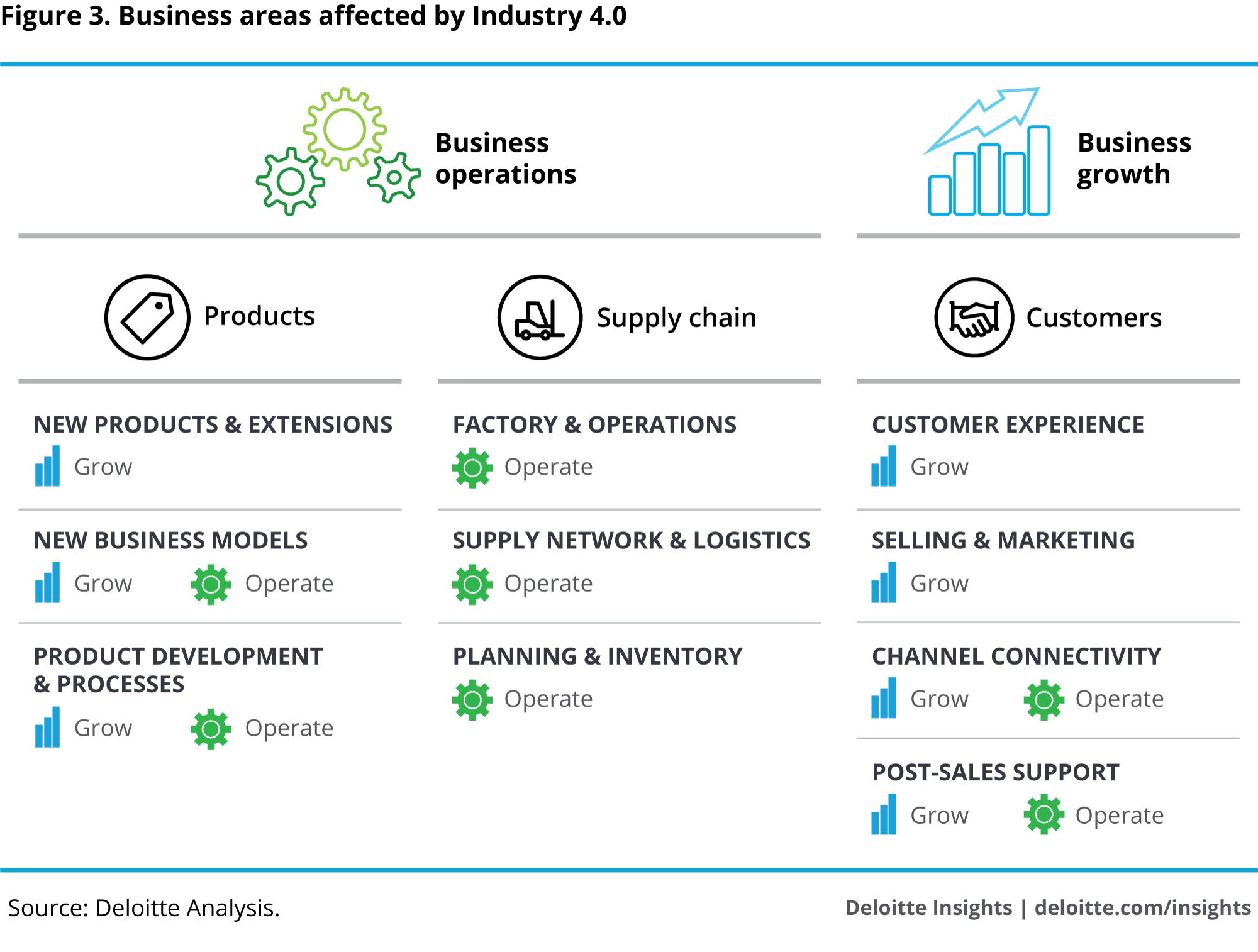Forces of change: Industry 4.0 has been saved

Forces of change: Industry 4.0
18 December 2017
We're in the middle of a fourth Industrial Revolution—and this one goes far beyond manufacturing. Smart, connected technologies are transforming how parts and products are designed, made, used, and maintained. And by ushering in a digital reality, they are transforming organizations themselves.
Executive summary
Industry 4.0 signifies the promise of a new Industrial Revolution—one that marries advanced production and operations techniques with smart digital technologies to create a digital enterprise that would not only be interconnected and autonomous but could communicate, analyze, and use data to drive further intelligent action back in the physical world. It represents the ways in which smart, connected technology would become embedded within organizations, people, and assets, and is marked by the emergence of capabilities such as robotics, analytics, artificial intelligence and cognitive technologies, nanotechnology, quantum computing, wearables, the Internet of Things, additive manufacturing, and advanced materials.
While its roots are in manufacturing, Industry 4.0 is about more than simply production. Smart, connected technologies can transform how parts and products are designed, made, used, and maintained. They can also transform organizations themselves: how they make sense of information and act upon it to achieve operational excellence and continually improve the consumer/partner experience.
In short, Industry 4.0 is ushering in a digital reality that may alter the rules of production, operations, workforce—even society.
What is Industry 4.0?
The Fourth Industrial Revolution, commonly known as Industry 4.0, appears to be changing the way businesses function and, by extension, the stakes by which they are forced to compete. Organizations must decide how and where to invest in these new technologies and identify which ones might best meet their needs. Without a full understanding of the changes and opportunities Industry 4.0 brings, companies risk losing ground.
Explore the Industry 4.0 collection
For business leaders accustomed to traditional linear data and communications, the shift to real-time access to data and intelligence enabled by Industry 4.0 would fundamentally transform the way they conduct business. The integration of digital information from many different sources and locations can drive the physical act of doing business, in an ongoing cycle.
Throughout this cycle, real-time access to data and intelligence is driven by the continuous and cyclical flow of information and actions between the physical and digital worlds. This flow occurs through an iterative series of three steps, collectively known as the physical-to-digital-to-physical (PDP) loop (see figure 1). To achieve this process, Industry 4.0 combines relevant physical and digital technologies, including analytics, additive manufacturing, robotics, high-performance computing, natural language processing, artificial intelligence and cognitive technologies, advanced materials, and augmented reality.1

- Physical to digital: Capture information from the physical world and create a digital record from physical data
- Digital to digital: Share information and uncover meaningful insights using advanced analytics, scenario analysis, and artificial intelligence
- Digital to physical: Apply algorithms to translate digital-world decisions to effective data, to spur action and change in the physical world
Connectivity within organizations is nothing new. Many organizations already have some portions of the PDP loop in place—namely, the physical-to-digital and digital-to-digital processes. It is the leap from digital back to physical—in other words, the ability to act upon data and information that has been analyzed—that constitutes the essence and value of Industry 4.0.2
Industry 4.0 is a global concept, but it can take many different forms, and names, around the world. In the United States, the focus tends to be more on a more holistic digital evolution, and many use the term digital supply network. Within Europe, where the concept originated, the phenomenon is known as Industry 4.0 and tends to be more factory-based. While the terminology may differ, the overall concept remains largely the same and encompasses the same technologies and applications.
Industry 4.0 extends far beyond the limits of the Industrial Internet of Things, which is typically where many explorations of the phenomenon begin and end. It also moves beyond the realm of manufacturing and production to focus on the entire ecosystem of partners, suppliers, customers, the workforce, and operational considerations.
In short, organizations should consider taking a holistic view of the Fourth Industrial Revolution and the ways in which it changes business. Industry 4.0 is about more than just advanced technologies: It is about the ways in which those technologies are brought together, and how organizations can harness them to drive operations and growth. We examine myriad topics, from the impacts of interconnectivity on cybersecurity concerns3 to the tax implications of operating in a digital realm,4 from applications of Industry 4.0 technologies in emerging areas such as predictive maintenance5 and the digital twin6 to a broad perspective of a fully connected digital supply network.7
Change seems to be coming fast—so fast, in fact, that it can be difficult to keep up. Industry 4.0 can feel difficult, if not impossible, to wrap one’s arms around. Through use of the PDP loop as an overarching framework, Deloitte provides a focused point of view that illustrates what Industry 4.0 is, what sets it apart from previous technological revolutions, and how its relevant technologies can create value for organizations.
Why does Industry 4.0 matter?
Industry 4.0 can transform organizations’ processes and operations. Below, we explore some key insights that can enable business leaders to visualize the ways in which the Fourth Industrial Revolution could affect their worlds.
Industry 4.0 touches everything in our daily lives
The Fourth Industrial Revolution is important to understand because it doesn’t just touch “manufacturers”—it can touch all of us.
While Industry 4.0 has grown to encompass business operations, the workforce, and society itself, its roots in the supply chain and manufacturing constitute the backbone of the world as we know it. What things are made of, how they are made, where they are made and how they get to us, and where they go when we need them fixed or we’re done using them: All of these things are part of the production life cycle.
Industry 4.0 will likely change how we make things, but it could also affect how those things are moved (through autonomous logistics and distribution),8 how customers interact with them, and the experiences they expect to have as they interact with companies.9 Beyond that, it could drive changes in the workforce, requiring new skills and roles.10
Industry 4.0 integrates the digital and physical worlds
The digitization of operations, manufacturing, supply networks, and products enables companies to combine learnings from humans, machines, analytics, and predictive insights to hopefully make better, more holistic decisions.11
Fully connected processes present huge opportunities: Rather than monitoring processes in a linear fashion, as has always been done, and operating reactively, companies can take learnings along the way and feed them back into the process, learn from what they are seeing, and adjust accordingly in real or near real time. This should lead to smarter decisions, better-designed products, service and systems, potentially more efficient use of resources, and a greater ability to predict future needs.
The digital thread represents one such end-to-end Industry 4.0 solution, linking the entire design and production process with a seamless strand of data that stretches from the initial design concept to the finished part.12 Beyond the digital thread, the use of the digital twin can enable organizations to gain insight into the inner workings of systems or facilities, simulate possible scenarios, and understand the impacts of changes in one node on the rest of the network.13
It’s not just about the supply chain or manufacturing—it’s about business operations and revenue growth
Industry 4.0 does not start and end with supply chain or production. Its reach could be much broader, affecting every industry and sector, even society itself. Industry 4.0 capabilities can improve business operations and revenue growth, transforming products, the supply chain, and the customer experience.
The marriage of digital and physical technologies would affect how customers, consumers, employees, and other parts of the business landscape expect to experience and interact with an organization. For their part, organizations that focus on the production and movement of information—such as finance, energy, technology, and health care—would face many of the same considerations as those that focus on the production and movement of physical goods: how to use information from connected systems to drive better products and services, customer experiences, and connections with vendors and other stakeholders.
Whatever their sector or industry, Deloitte has identified three key areas in which Industry 4.0 can have the most impact:
Products
Industry 4.0 technologies can transform the way products are designed and developed. Connected technologies can also lead to completely new products and services. The use of sensors and wearables, analytics and machine learning, and advanced manufacturing in the form of additive manufacturing, advanced computer numerical control, and robotics can enable product improvements in various ways, from enabling rapid prototyping and testing to adding connectivity to previously unconnected products, to innovative new offerings.14
Finally, they can lead to new business models, as companies can sell data and services in addition to physical objects. Data from products out in the field could also be very important. Digital signals from customer interactions with fielded assets—or from the assets themselves—can enable better service, improved warranty claims, visibility into usage patterns, and data to monetize.
Supply chain
Every company has a supply chain, although the shape it takes is unique depending on operational needs. Whether the chain comprises materials, parts, and other physical matter or data, information, and expertise, organizations depend on external inputs to operate. Industry 4.0 can enable the smart factory, connect supply network and logistics capabilities, and inform planning and inventory processes, along with a host of other capabilities, enabling organizations to know things they didn’t know before.
These capabilities can become particularly salient when viewing the changes that Industry 4.0 brings to all stakeholders in an ecosystem. Smart, connected, digital technologies would change how consumers and other parts of the business landscape expect to experience whatever it is they are going to experience when they interact with a company or its products and services. This, in and of itself, would create challenges and opportunities in the supply chain, some of which can be realized by leveraging Industry 4.0 solutions.15
Customers
Across all stages of the customer journey, Industry 4.0 can create new opportunities for innovation and growth. Data gathered through intelligent products and services can enable a deeper understanding of customers. Information from connected systems can enhance the customer experience, direct selling and marketing strategies, and better enable companies and their partners to offer post-sales support to customers, strengthening the customer relationship.16
Customer experience in the age of Industry 4.0 would be driven not just by the physical object but by the information, analytics, and customization that make the customer’s interaction with that object more transparent, and the ways the company takes action on the insights they gather.17 In this way, organizations can use the principles of the PDP loop to better engage their audiences, maintain a stronger degree of connection both internally and throughout their network, and better monetize products and services.
What are the impacts of Industry 4.0?
The effects of Industry 4.0 can be felt at multiple levels: across entire ecosystems, at the organizational level, and at the individual employee and customer level. Below, we explore each.
Connecting ecosystems: Driving better decisions
At its broadest level, Industry 4.0 portends a shift not only in how companies would operate and goods would be produced, but how ecosystems—the suppliers, customers, regulatory considerations, investors, and other third-party experts and influencers—would function and interact. Industry 4.0 technologies create the potential for interactions between every point of a network. Thus, stakeholders can work together more effectively, using a constant stream of data from connected systems to learn and adapt to new conditions, and even begin to predict rather than react.
While the supply chain is not the only application of advanced, Industry 4.0 technologies, it seems to provide a useful illustration of the ways in which Industry 4.0 can connect an ecosystem, enabling stakeholders to integrate information from many different sources and make more holistic decisions. This shift from linear, sequential business operations to an interconnected, open system can change industries and lay the foundation for how companies operate, collaborate, and compete in the future.18 (See figure 2.)

Evolving organizations: Adapting to new pressures and demands
Most organizations continue to contend with a host of organizational and ecosystem-wide changes exerting pressure on their operations, including:19
- Rapidly evolving technological capabilities
- Increased supply chain complexity and global fragmentation of production and demand
- Growing competitive pressures from unexpected sources
- Organizational realignments resulting from the marriage of digital and physical technologies
- Ongoing talent challenges
Industry 4.0 offers ways that can potentially address some of those issues. The ability to adjust to and learn from data in real time can make organizations more responsive, proactive, and predictive, and enables the organization to possibly avoid operational downtime and other productivity challenges.
Within the organization itself, the impacts of Industry 4.0 could be perhaps most distinct and specific. New business outcomes may emerge from the integration of digital and physical technologies in Industry 4.0. Broadly speaking, those outcomes can be divided into two key areas: operations improvements and revenue growth.20 (See table 1.)

Operational improvements can focus on enhancements to productivity (such as improving labor efficiencies and managing costs and schedule accuracies) and reduction to risk (such as mitigating vendor, data, and geographic risks and ensuring availability of supplies). For its part, revenue growth can include incremental revenue improvements (such as finding new efficiencies in the core business, and using customer data to deepen customer understanding and integration) and wholly new revenue streams (such as using data from connected systems to create new products and services or using demand data and digital technologies to expand more easily into new markets).
Depending on where a company’s focus lies, leaders may pursue different opportunities within both areas. Both operating and growing a business map to different activities across the three key areas of products, the supply chain, and customers referenced in the Key Insights section of this document. Organizations can use Industry 4.0 technologies to pursue growth and operational excellence across multiple verticals. (See figure 3.)

How organizations choose to prioritize operations versus growth can serve as a guide as to which areas could merit the greatest attention with respect to adoption of Industry 4.0—and even which technologies might warrant deeper investment.
Enabling individuals: Challenging and empowering both workers and customers
Industry 4.0 likely means different things for different individuals. For employees, Industry 4.0 could signify a shift in the work they are expected to do, and how they are expected to do it. For the customer, Industry 4.0 could enable greater customization and products and services that better meet their needs.
Shifting demands for the workforce
The rise of smart automation and ubiquitous, connected systems in the age of Industry 4.0 appears to herald a change in what organizations could ask of their workers: what skills they require, what tasks need to be done, even what roles would be needed.21 These changes can feel nebulous as Industry 4.0 itself is still nascent, and the contours of its fuller impact continue to shift. However, they may not necessarily mean the loss of jobs: In the United Kingdom, for example, technology helped to create 3.5 million new jobs between 2001 and 2015, even while it contributed to the loss of 800,000.22
At the individual level, Industry 4.0 can both enable and challenge workers to do much more. Connected enterprises could mean the creation of troves of data, while the marriage of digital and physical worlds may compel workers to perform complex, variable, and often unpredictable tasks that require an ability to access and understand that data.23 Further, new technologies—and the ways in which they are incorporated into workflows and the day-to-day functions of the organization—can mean new training needs. Individuals will need to navigate how they interact with and work alongside Industry 4.0 technologies, and how their responsibilities and roles may evolve as a result.
The impact of Industry 4.0 on workers can, and likely will, take many shapes. Smart digital and physical technologies can be used as tools to enhance workers’ jobs and make tasks easier. Their contributions can even rise beyond that to a broader partnership in which autonomous technologies work alongside people—each leveraging their inherent strengths to achieve an outcome greater than either could accomplish alone.24 They may also give rise to wholly new roles, just as they enable new products and services.25
A more tailored, engaging experience for customers
While we have already explored Industry 4.0’s potential effects on customers, it could carry significant benefits for every stage of the customer, from initial research and sales to account management and aftermarket service.26
The PDP loop provides an explanation for the ways in which Industry 4.0 might benefit customers: They interact with the company in some way through its products, services, or other touchpoints, creating data that can then be analyzed to drive an action tailored to the customer’s needs or behavior. Further, that data can be aggregated with historical information and data from other clients to better understand and even predict customer preferences, or be fed back into the research and development process to inform better-designed offerings.
What should you do next?
There is little doubt that penetration of Industry 4.0 concepts in companies’ processes and operations will grow. Information flow, advanced technologies, and materials—in other words, the digital and physical technologies that comprise Industry 4.0—make it possible to access real-time information and insights throughout an organization to drive actionable insights. This, in turn, enables companies to accomplish entirely new things in entirely new ways and potentially revolutionize supply chains, production, and business models.
As you consider your approach to Industry 4.0, you can take the following actions:
Get immersed in innovation. Explore the art of the possible to push the organization to understand the application of various technologies and their potential impacts on the business. Understand what drives your need to differentiate and start to think about how to get there.
Build an ecosystem. Assess the organization’s digital maturity to understand what might be feasible, and what steps should be taken to build the necessary technological capabilities with the resources you already have in place, versus what new resources you might need to acquire to get there. Beyond the technologies themselves, consider the expert resources you may want to cultivate, either externally or internally, as part of your Industry 4.0 network.
Scale at the edges. At times, it makes sense to start with smaller stakes, where strategies can be tested and refined with relatively fewer consequences. Selecting projects at the “edges” of the organization can provide greater latitude for building out Industry 4.0 at a broader scale, and can also help individuals feel less afraid to fail, which could ultimately lead to greater innovation.
Start with one or two transformations to prove it works. Prioritize areas that can unlock several waves of potential value, and consider then building on those successes for exponential growth. Initial successes can serve as proof points, leading to a greater willingness to take a chance on more substantive investments.
Don’t wait for perfect, and keep iterating. Industry 4.0 technologies seem to be rapidly evolving, and there is typically room to iterate. Learning from previous experiences can inform the next set of initiatives and help home in on the next list of priorities.
Changes are happening quickly. But with change often comes opportunity: Industry 4.0’s ability to play an integral role in strategic decision-making, broader ecosystem integration, and customization of products and services to the specific needs of customers and clients. Establishing a competitive advantage requires the willingness to join the fray.
Are you ready to get started?
Deloitte Insights Industry 4.0 Collection
To learn more about our research and explore the full Industry 4.0 collection, visit the Industry 4.0 collection page on Deloitte Insights.
© 2021. See Terms of Use for more information.




